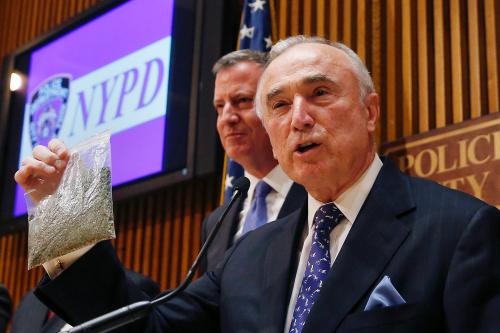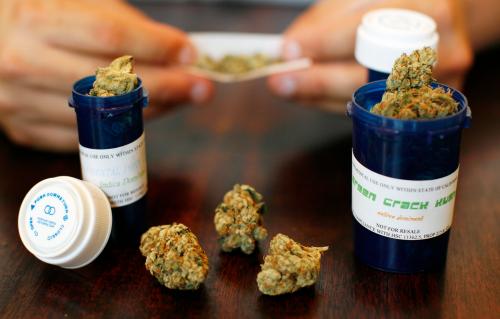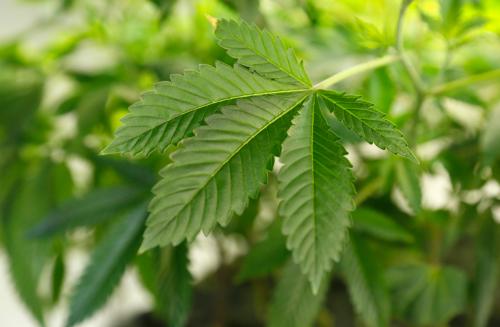Editor’s Note: This post was published on August 11, 2016, shortly before the Drug Enforcement Administration published its announcement regarding marijuana policy in the federal register.
Today the Drug Enforcement Administration is expected to announce its decision on a five-year-old marijuana rescheduling petition. After a long wait and amid wild speculation about the agency’s intentions, DEA has decided to keep marijuana as a Schedule I substance, but to take the unexpected step of ending the monopoly on the production of research grade marijuana.
This move will certainly disappoint many in the marijuana reform community who hoped that DEA would change marijuana’s status. Under current policy—and now continuing policy—marijuana is categorized along with heroin and LSD as a substance that has no medical value and that has a high potential for abuse. Reformers hoped that the administration would accept the claim that marijuana has medical benefit and can be used safely in treatment. Today, it is opting not to do so.
However, DEA, in a clear sign of the growing political complexity around cannabis policy in the United States, will strike a balance. Rather than wholly maintaining the current policy, the administration nixed a different stumbling block to the study of marijuana and its efficacy as a medical product: the DEA mandated monopoly on the growth of marijuana for research (administered through the National Institutes on Drug Abuse). The DEA-mandated NIDA monopoly was cited as a significant barrier to research by observers like myself, Mark Kleiman and many others, as well as clinical researchers themselves.
Despite reformers’ discontent, this decision may be more meaningful than the ultimate goal of rescheduling for both policy and political reasons. It’s important to walk through the context of this policy.
The realities of drug rescheduling
As my colleague Grace Wallack and I wrote last year, marijuana rescheduling is among the most misunderstood concepts in the drug policy arena. Rescheduling marijuana from Schedule I to Schedules II, III, IV, or V would not have legalized marijuana. Nor would it have legalized medical marijuana. It would not even legitimize the systems in 25 states and DC that have approved medical marijuana.
Instead, rescheduling to the category most widely expected, Schedule II, would have made marginal changes to the certification and security rules governing researchers seeking to conduct federally-approved studies using marijuana. Schedule II status would have very little, if any, impact for the broader cannabis community.
Despite the misinformed doomsday naysayers in the marijuana reform community who argued that rescheduling would have released the hounds to shut down the industry, rescheduling would not have done that either. As I argued (with Grace Wallack) earlier this year, the idea that the federal government would shutter the marijuana industry by using a civil/administrative tool—preemption—was misplaced; those fearing preemption believed that only under a different schedule would FDA have the authority to enjoin existing marijuana programs by claiming that marijuana was not medicine, despite being labeled as such in the states. That belief failed to acknowledge FDA’s existing power to do so under Schedule I and failed to place the legal power of the US government in the context of the politics of the day and the administrative structure of the executive branch.
All those who believed rescheduling would be manna from Heaven, or the devil incarnate tossing the cannabis industry into eternal flames, exaggerated a minor administrative action. That said, rescheduling would not be meaningless. If approved, it would have made an important statement about cannabis: that it has medical value. Although this change would have been largely symbolic, it would have been a dramatic shift in the government’s perception of cannabis that has held firm for decades.
Would rescheduling have mattered had DEA gone in a different direction today? Absolutely.
Would rescheduling have had a significant effect on the day-to-day lives of cannabis business owners, consumers, patients, regulators, state officials, etc.? No.
Extinguishing the medical marijuana monopoly
While both rescheduling and ending the NIDA monopoly would impact the clinical marijuana research community most directly, addressing the NIDA monopoly may well deserve greater applause from drug policy reformers for three key reasons.
-
Researchers’ access and government intrusion
Under the NIDA monopoly, researchers complained for decades about numerous aspects of the supply of research-grade marijuana. Slow delivery, product that included plant components other than flower, a lack of diversity of strains and potency, an inability to custom order product with specific cannabinoids profiles, and a difficulty accessing alternative products like extracts have hindered research for some time. Instead of having access to the marijuana researchers were interested in employing in experiments—because of theory and prior research, they were forced to tailor studies to the product available from the University of Mississippi monopoly.
This situation presented a serious threat to the legitimacy of research and put the government between scientists and the answers they sought. The government was complicit in holding science back and the monopoly was largely to blame. While the result was not a malicious effort from the grower(s) charged with administering the monopoly, the results of the policy were dangerous for the empirical study of cannabis, nonetheless.
Expanding the number of federally-approved growers will offer researchers diversity in terms of how to access study drugs and, most likely, the diversity of the product itself. Like a monopoly in any setting, supply is restricted as the forces of competition are limited. As the number of firms expand, product becomes more readily available and diversity, innovation, and market forces allow consumers greater choice. Ending the NIDA monopoly allows such basic forces of supply and demand to seep into an important area of scientific inquiry. What’s more, many of those who have sought over the years to open additional grow operations—like the University of Massachusetts’ Lyle Craker—understand the impact the monopoly has had on the marijuana research community. As a result, additional grows will be particularly sensitive to the challenging history behind this policy and work closely with researchers to meet their scientific needs. That is a win for science and a good day for anyone who wants questions about medical value to be answered by science and not government.
-
Ending the NIDA monopoly may facilitate future rescheduling
Under current policy, marijuana is stuck in what I like to call the cannabis catch-22. It remains a Schedule I substance because it is designated as having no medical value, and its Schedule I status (and related policies like the NIDA monopoly) make it difficult to research whether it has medical value. Thus, a vicious cycle ensues in which cannabis is trapped in Schedule I, regardless of its potential medical value.
Ending the DEA-mandated NIDA monopoly will mean that better, more careful, more precise, more theoretically-driven research can be conducted. That means better, more convincing answers to one of the central questions in this policy space: does marijuana have medical value. If the expansion of federal grow sites leads to better research, the scientific community will be equipped with greater evidence to answer that question, and if those studies show medical value, marijuana rescheduling will be more likely.
Although for some, marijuana rescheduling seems like a no-brainer, there is skepticism within the medical community about the value of the drug as a medicine. Surely part of that is cultural, but part of it, too, stems from limitations on research. Any effort to improve and expand research will help convince the broader medical community of the right answer to this central question. And while some medical associations have called for rescheduling, many large groups have simply asked for more research. Ending the NIDA monopoly meets that demand and may ultimately push the nation’s largest medical associations to call for rescheduling.
-
Rescheduling is coming and DEA knows it
It is common knowledge that while agencies operate according to bureaucratic processes, they are also very aware and very sensitive to politics, present and future. There are a few realities that DEA must be explicitly aware of. First, public opinion about marijuana has changed dramatically in the past 25 years and continues to shift in the direction of reform. Nearly 60 percent of Americans support reforming policies around adult-use marijuana and more than 75 percent support reforms around medical marijuana.
The days of prohibition, the days of public fear of marijuana, and the days of a public agreeing that marijuana is as dangerous as heroin or LSD have come to an end. In the process, policies like marijuana’s Schedule I status have adopted a very short shelf-life. During the Obama Administration, we have seen such movement. Between the Cole Memos creating a legal space in which cannabis enterprises can operate, the removal of the Public Health Service’s duplicative review of marijuana research proposals, and the Treasury Department’s efforts to encourage banking access for the cannabis industry or the numerous proposals in Congress seeking reform, the times for marijuana are a-changin’.
DEA is hyper-aware of these societal changes, and it has also seen policy change in the current administration as a signal of what is to come. Such changes and political realities may well have pushed the agency to end the NIDA monopoly in an effort to find a middle ground on the issue of rescheduling, particularly as DEA reasserted the NIDA monopoly just last year.
What’s more, both presidential candidates—Hillary Clinton and Donald Trump—have indicated they have no interest in shutting down the marijuana industry come January 20th. In fact, Hillary Clinton, the candidate heavily favored to win the presidency at the time of this announcement, has called for marijuana rescheduling and expanded research. If elected, Clinton and her team may well push for rescheduling, making the current decision by DEA a temporary one.
For marijuana reform supporters, DEA’s decision to continue marijuana’s Schedule I status may well present a political opportunity for the next administration. If marijuana had been rescheduled, a new administration could have been sworn in next January with the idea that the problems facing the marijuana industry and community were “fixed” and that no further action need be taken. The reality is that America’s marijuana policy is schizophrenic and sclerotic. Changes are necessary to solve the numerous problems that have been created by a pseudo-legal, contradictory policy system.
The worst thing the next president can do when it comes to marijuana policy is to do nothing, and allow policy challenges and shortcomings to fester and grow. (Though reformers would surely argue the worst thing would be to shut the system down.) DEA’s decision today may sting for the reform community and will fall far short of their expectations and desires. However, if come January a new president is sworn in who looks at the drug policy landscape and sees both a system in need of repair and a policy with reforms that can garner bipartisan, bicameral support in Congress, DEA’s stubbornness on rescheduling may ultimately become reformers’ blessing in disguise.
The Brookings Institution is committed to quality, independence, and impact.
We are supported by a diverse array of funders. In line with our values and policies, each Brookings publication represents the sole views of its author(s).







Commentary
The DEA’s marijuana decision is more important than rescheduling
August 11, 2016